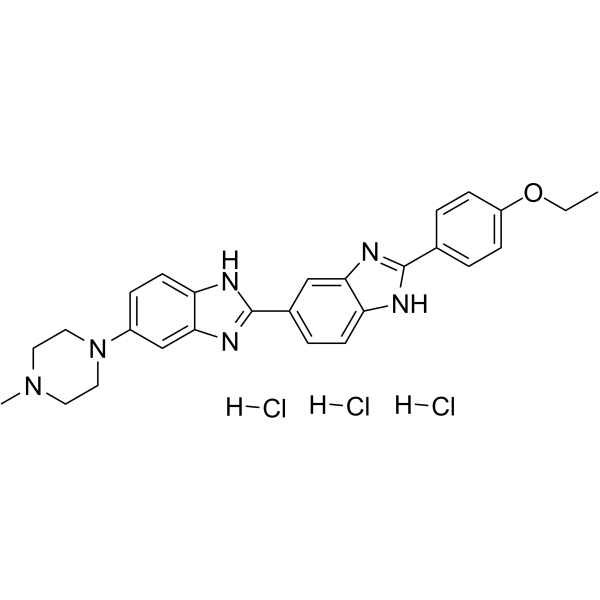All AbMole products are for research use only, cannot be used for human consumption.

Hoechst 33342 trihydrochloride is a membrane permeant blue fluorescent DNA stain. Hoechst binds to the grooves in the DNA double strand, which tends to be A/T-rich DNA strand. Although it binds to all nucleic acids, the A/T-rich double strand DNA significantly enhances fluorescence intensity Therefore, Hoechst dye can be used for living cell labeling. The fluorescence intensity of Hoechst dye increases with the increase of pH of solution.
*The compound is unstable in solutions, freshly prepared is recommended

Biomed Pharmacother. 2025 Apr 24.
The roles and mechanisms of CDGSH iron-sulfur domain 1 in kainic acid-induced mitochondrial iron overload, dysfunction and neuronal damage
Hoechst 33342 trihydrochloride purchased from AbMole

J Control Release. 2024 Oct;374:400-414.
An “Iron-phagy” nanoparticle inducing irreversible mitochondrial damages for antitumor therapy
Hoechst 33342 trihydrochloride purchased from AbMole

Smart Mater Med. 2024 Jun.
Construction of an Uricase/Catalase/Curcumin-co-loaded Drug Delivery System and its Effect on Hyper-uric Acid-induced Kidney Injury
Hoechst 33342 trihydrochloride purchased from AbMole

Toxicol Appl Pharmacol. 2024 Sep 24.
Human trophoblast organoids for improved prediction of placental ABC transporter-mediated drug transport
Hoechst 33342 trihydrochloride purchased from AbMole

Carbohydrate Polymers. 2023 Dec 1.
Chitosan-based nano-micelles for potential anti-tumor immunotherapy: Synergistic effect of cGAS-STING signaling pathway activation and tumor antigen absorption
Hoechst 33342 trihydrochloride purchased from AbMole

J Transl Med. 2023 Aug 12;21(1):540.
Decreased cyclooxygenase-2 associated with impaired megakaryopoiesis and thrombopoiesis in primary immune thrombocytopenia
Hoechst 33342 trihydrochloride purchased from AbMole

Front Oncol. 2023 Mar 29;13:1140256.
Near-infrared fluorescence imaging of hepatocellular carcinoma cells regulated by β-catenin signaling pathway
Hoechst 33342 trihydrochloride purchased from AbMole

Evid Based Complement Alternat Med. 2022 Apr 6;2022:4445293.
Zhenzhu Xiaoji Decoction Induces Autophagy and Apoptosis Cell Death in Liver Cancer Cells through AKT/mTOR and JAK2/STAT3 Signaling Pathway
Hoechst 33342 trihydrochloride purchased from AbMole

PLoS Pathog. 2021 Feb 8;17(2):e1008992.
CVB3 VP1 interacts with MAT1 to inhibit cell proliferation by interfering with Cdk-activating kinase complex activity in CVB3-induced acute pancreatitis
Hoechst 33342 trihydrochloride purchased from AbMole

Gastric Cancer. 2020 Mar;23(2):241-259.
The modification of ferroptosis and abnormal lipometabolism through overexpression and knockdown of potential prognostic biomarker perilipin2 in gastric carcinoma.
Hoechst 33342 trihydrochloride purchased from AbMole
| Molecular Weight | 561.93 |
| Formula | C27H31Cl3N6O |
| CAS Number | 875756-97-1 |
| Solubility (25°C) | DMSO ≥ 45 mg/mL Water ≥ 5.5 mg/mL |
| Storage | 2-8°C, protect from light, dry, sealed |
[4] Brad Chazotte. Cold Spring Harb Protoc. Labeling nuclear DNA with hoechst 33342
| Related Fluorescent Dye Products |
|---|
| pH Fluorescent Probe Red 600, SE
pH Fluorescent Probe Red 600, SE is a pH-sensitive fluorescent dye, the fluorescence intensity changes significantly with changes in the pH of the environment. pH Fluorescent Probe Red 600, SE is weakly fluorescent outside the cells, but its fluorescence is significantly enhanced in acidic compartments (such as phagosomes, lysosomes and endosomes). It can be used for multiplexing cellular functional analysis with green dyes such as GFP, Fluo-8, calcein, or FITC-labeled antibodies. Ex (nm) 576, Em (nm) 597 |
| DSPE-Rhodamine
DSPE-Rhodamine is formed by the conjugation of DSPE with the Rhodamine fluorescent dye. DSPE possesses a hydrophobic lipid tail and a hydrophilic head group, while Rhodamine is a red fluorescent dye. DSPE-Rhodamine retains the lipid properties of DSPE while also imparting fluorescent labelling capabilities. As a key component of delivery systems, DSPE-Rhodamine enhances targeting and bioavailability. Its lipid properties facilitate the penetration of molecules through cell membranes, while its fluorescent properties enable tracking of distribution and dynamic changes within the body. |
| LD540
LD540 is a novel high-sensitivity lipophilic dye modified with BODIPY fluorescent groups, designed for precise labelling and imaging of lipid droplets. LD540 exhibits excellent photostability and an optimal fluorescence spectrum, making it compatible with various commonly used fluorescent dyes (such as DAPI and Alexa Fluor 647), thereby supporting multi-colour imaging requirements. Additionally, LD540 is suitable for both fixed and live cells and can label ultra-small lipid droplets. |
| PDMPO
PDMPO (Yellow/Blue DND-160) is a ratiometric probe for the determination of lysosomal pH for fluorescence imaging. PDMPO exhibits pH-dependent dual excitation and dual emission peaks. PDMPO produces blue fluorescence (Ex/Em=329 nm/440 nm) in weakly acidic organelles, and in more acidic lysosomes it becomes yellow fluorescence (Ex/Em=384 nm/540 nm). |
| Copper probe CF4
Copper probe CF4 (Copper fluor CF4) is a Cu+-specific fluorescent probe based on a rhodol dye scaffold. Copper probe CF4 (Copper fluor CF4) has high copper selectivity with a Kd value of 2.9×10-13 M, particularly over zinc and iron, as well as abundant cellular alkali and alkaline earth metals. Copper probe CF4 (Copper fluor CF4) is stable in a physiologically relevant pH regime between 6 and 8 (wavelengths of 415 nm for excitation and 660 nm for emission). Copper probe CF4 (Copper fluor CF4) can be used to study colon cancer. |
All AbMole products are for research use only, cannot be used for human consumption or veterinary use. We do not provide products or services to individuals. Please comply with the intended use and do not use AbMole products for any other purpose.


Products are for research use only. Not for human use. We do not sell to patients.
© Copyright 2010-2024 AbMole BioScience. All Rights Reserved.
